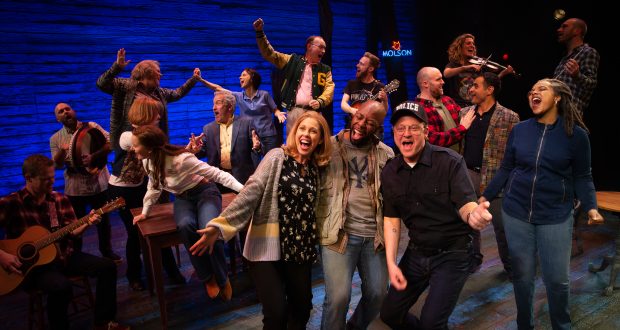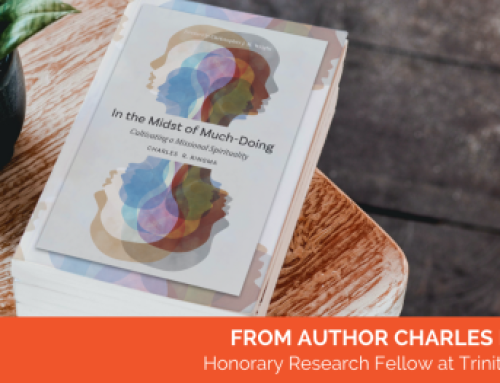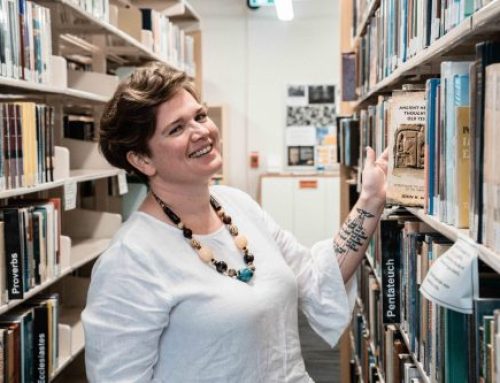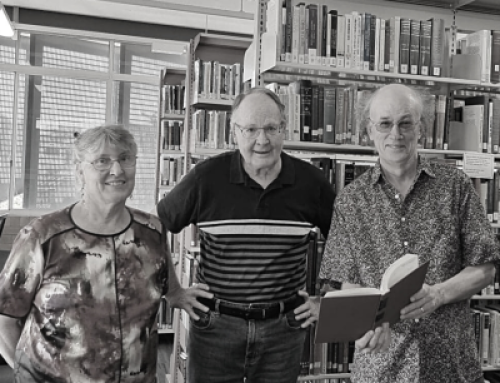In 2019 Trinity College Queensland welcomed submissions for The Religious Faith and Belief Award which was designed to encourage interaction with religious faith, culture, current affairs and how these relate to contemporary Australian society. The award-winning essay was written by Matthew Ventura on the Broadway production Come From Away.
September 11, 2001. I was only six-years-old at the time and my childhood memories are scarce, but I can still picture vividly where I was that morning. Nearly every Australian I know remembers where they were that day. I have images burned into my brain—images of smouldering ruins and weeping survivors. I was at Harvey Norman in the TV display section, and everywhere I looked, TVs were screening live news coverage. I couldn’t look away even if I had the willpower to try. The 9/11 terrorist attacks sent shockwaves across the world that day that still shape Western culture in more ways than we can imagine.
But on that very same day, another story was taking place. This story took place on a small Canadian island, where 7000 terrified airline passengers were forced into emergency landings when the US airways shut down in response to the terrorist action. This story showed the transformational power of unexpected kindness as the local townsfolk warmly welcomed these refugees into their crowded homes and gave them a glimpse into a different way of life for five days. It is the story of Come From Away.
The Broadway production of Come From Away (CFA) opened in March 2017. It uses the popular medium of musical theatre to tell the true stories of survivors and locals on the island of Newfoundland in the week following 9/11. It is a powerful redemption story of human connection in the face of isolation and tragedy. More than that, CFA acts as a modern myth providing a culture-shaping narrative of generous pluralism that trumps religious and national divides.
What do I mean by a myth? Surely this is a true story. Every part of CFA is based on factual events after interviewing real people. I refer to “myth” in the deeper sense of the word: a story with immense cultural value that people retell to remind each other of who we are and how we should act. In the wake of 9/11, the Western world was desperate for a way to make sense of human nature and a model for co-existing peacefully with multiplicity of worldviews.
“We live in a world that has lost its connection to its traditional myths, and we are now trying to find new ones—we’re people, and that’s what people without myths do. These myths will shape our future, how we live, what we do, and what we buy. They will touch all of us.”1
This is why the simple story of CFA has so quickly become culturally iconic. It presented a narrative of generous religious pluralism at the exact same moment when radicalised religious extremists threatened to divide the world.
The show opens with 38 international jets from all around the world touching down at Gander Airport, Newfoundland. As well as the plethora of national cultures represented, there is a rich diversity of religious worldviews; among the Newfoundlander locals are “Protestants, Baptists, Catholics, Salvation Army-ists…”2 as well as Muslim, Jewish and Hindu travellers. What is particularly interesting is that these worldviews are not depicted as shallow statistical data, nor does any single worldview dominate the perspective of the storytelling. Instead, each faith tradition is treated with as much depth and nuance as the character’s true story deserved.
These huge cultural and religious differences between strangers amplify the richness of human connection that runs throughout the entire story. In one particularly moving scene (Darkness and Trees), the extreme cultural unfamiliarity hits home. A plane full of African people are escorted into a bus after 28 hours of waiting in the plane for security processing. When they finally arrive at the church where they are being housed, Salvation Army volunteers stand waiting dressed in uniform. However, since none of the African people speak English, they mistake the Salvation Army for uniformed soldiers, see foreign security guards with guns, and naturally they assume they’re being taken to a prison camp of some sort. Terrified, they refuse to leave the bus, and with no translator, they despair of hope. Finally, the Canadian bus driver notices one of the women clutching a Bible. He can’t read the language, but he figures that the verse system would be the same as the English Bible he has read many times, so he gently takes the Bible in his hands and turns to Philippians 4:6. This is clearly a verse so meaningful to him that he has the reference memorised. He hands the Bible back to the African people, pointing to the verse to reassure them: “Be anxious for nothing.” This marks a beautiful turning point where they start communicating across language and cultural barriers through their shared sacred text. This development humanises a group of foreigners, transforming the viewer’s perspective to stop seeing them as a foreign “other,” and begin to connect with them as a fellow human, a spiritual being with shared faith.
The story goes even further, showing people of different faiths connecting deeply. The song titled “Prayer” starts with an agnostic man reciting the Prayer of St Francis which he recalls from his childhood, then introduces a Polish holocaust survivor who has never told another human of his Jewish heritage—not even his wife—until this moment when he finally seeks out a rabbi to disclose his secret to. Before this poignant meeting has even had time to register, we meet a Muslim man struggling to pray at Dhuhr under the suspicious stares of Islamophobic people. A kind local lady meets him and shows him to the library which has been designated a quiet place for prayer. As he walks in, he sees the rabbi and Polish man singing a Jewish prayer together and some Hindu passengers worshipping before kneeling down next to them and reciting his own prayers alongside his companions. The song climaxes with a heartfelt chorus of all these different prayers in different languages interwoven in perfect harmony—both musical and metaphorical.
What is particularly profound about this portrayal of faith is that it isn’t the shallow, “we’re- all-basically-the-same” picture of religion we’ve come to expect in media. Instead of straining at superficial similarities, the CFA story leans deeply into the rich pluralism of different faiths and cultures that are radically different from each other, and depicts the beauty of loving our fellow human across these differences. It is precisely this “love-for- other” experience that transforms passengers in their five days on the island and leaves them singing the bittersweet line “You’ve found your heart but left a part of you behind,” as they eventually fly home.
This rich portrayal of religious pluralism flies in the face of both rising islamophobia3 and suspicion of public religion triggered by 9/11.4 Rewriting the narrative of terror and radicalised extremism, CFA celebrates the extraordinary freedom in Western society to worship openly and be different. The CFA myth abolishes the 9/11 narrative of fearful xenophobia and replaces it with a myth of shared humanity and compassion.
If there were any doubt about the mythic status of this true story, its reception quickly affirms its culture-shaping power. It remarkably took only two years for the Broadway show to tour to Australia, where it has been so warmly embraced that its initial season of a few months has been extended several times to nearly half a year of non-stop shows. Nearly everybody who has seen this show describes it as having tangibly altered their life. A quick Google search of show reviews will reveal how frequently the phrase “restored faith in humanity” features. While this phrase may sound cliché, it is precisely the hope-filled response that a myth would evoke, prompting thousands of Australians to reimagine their understanding of who we are and how we must live.
Already this myth is transforming culture in extraordinary ways. A CBC documentary describes the phenomenon known as “Gander Ripple Effect.”5 It describes responses to the CFA myth including united efforts of faith-based communities raising funds to sponsor Syrian refugee families to relocate to Gander, the small town that once hosted 7000 refugees from all around the world. In a short time, four Syrian families have already been fully sponsored and embraced by the Gander community, with a fifth family set to arrive in early 2020.
Though the show only reached Australia in September, audiences have hungrily devoured the myth. In a world so nervous of public religion and gripped by fear of “other,” Come From Away is the modern myth Australia needs and longs for. It inspires us with a picture of generous religious pluralism and devotion to the “outsider” in a way that reminds us of these words from James’ epistle: “Pure and undefiled religion in the sight of our God and Father is this: to visit orphans and widows in their distress, and to keep oneself unstained by the world.” (James 1:27)
Matthew Ventura
Matthew Ventura is a ministry trainee at Living Church City South and has a background in the performing arts as a professional bassoon player.
1 Sachs, Jonah. Winning the story wars: Why those who tell (and live) the best stories will rule the future. Harvard Business Press, 2012, 6.
2 Beulah Davis in Scene 19.
3 Panagopoulos, Costas. “The polls-trends: Arab and Muslim Americans and Islam in the aftermath of 9/11.” International Journal of Public Opinion Quarterly 70, no. 4 (2006): 608-624.
4 Ormerod, Neil. “Secularisation and the “Rise” of Atheism.” Australian eJournal of Theology 17 (2010): 13-22.
5 Gander Ripple Effect. Directed by Angela Antle. CBC Newfoundland and Labrador, 2018. Accessed December 17, 2019 https://www.youtube.com/watch?v=62_Mf6rhhPE
Bibliography
Byers, Bryan D., and James A. Jones. “The impact of the terrorist attacks of 9/11 on anti-Islamic hate crime.” Journal of Ethnicity in Criminal Justice 5, no. 1 (2007): 43-56.
Gander Ripple Effect. Directed by Angela Antle. CBC Newfoundland and Labrador, 2018.
Ormerod, Neil. “Secularisation and the “Rise” of Atheism.” Australian eJournal of Theology 17 (2010): 13-22.
Panagopoulos, Costas. “The polls-trends: Arab and Muslim Americans and Islam in the aftermath of 9/11.” International Journal of Public Opinion Quarterly 70, no. 4 (2006): 608-624.
Sachs, Jonah. Winning the story wars: Why those who tell (and live) the best stories will rule the future. Harvard Business Press, 2012, 6.
Walsh, Andrew. “Returning to normalcy.” Religion in the News 5, no. 1 (2002): 26-28.






